Deck 12: Vectors and the Geometry of Space
Question
Question
Question
Question
Question
Question
Question
Question
Question
Question
Question
Question
Question
Question
Question
Question
Question
Question
Question
Question
Question
Question
Question
Question
Question
Question
Question
Question
Question
Question
Question
Question
Question
Question
Question
Question
Question
Question
Question
Question
Question
Question
Question
Question
Question
Question
Question
Question
Question
Question
Question
Question
Question
Question
Question
Question
Question
Question
Question
Question

Unlock Deck
Sign up to unlock the cards in this deck!
Unlock Deck
Unlock Deck
1/60
Play
Full screen (f)
Deck 12: Vectors and the Geometry of Space
1
Find an equation of the set of all points equidistant from the points  and
and 
A)
B)
C)
D)
E)
 and
and 
A)

B)

C)

D)

E)


2
Reduce the equation to one of the standard forms. 
A)
B)
C)
D)
E)

A)

B)

C)

D)

E)


3
Find the point at which the line given by the parametric equations below intersects the plane. 
A)
B)
C)
D)
E)

A)

B)

C)

D)

E)


4
Find an equation of the plane that passes through the line of intersection of the planes  and
and  is perpendicular to the plane
is perpendicular to the plane 
 and
and  is perpendicular to the plane
is perpendicular to the plane 

Unlock Deck
Unlock for access to all 60 flashcards in this deck.
Unlock Deck
k this deck
5
Find an equation for the surface consisting of all points P for which the distance from P to the x-axis is  times the distance from P to the yz-plane.
times the distance from P to the yz-plane.
A)
B)
C)
D)
E)
 times the distance from P to the yz-plane.
times the distance from P to the yz-plane.A)

B)

C)

D)

E)


Unlock Deck
Unlock for access to all 60 flashcards in this deck.
Unlock Deck
k this deck
6
Find parametric equations for the line through  and
and 
 and
and 

Unlock Deck
Unlock for access to all 60 flashcards in this deck.
Unlock Deck
k this deck
7
Find an equation for the surface obtained by rotating the parabola  about the y-axis.
about the y-axis.
A)
B)
C)
D)
E)
 about the y-axis.
about the y-axis.A)

B)

C)

D)

E)


Unlock Deck
Unlock for access to all 60 flashcards in this deck.
Unlock Deck
k this deck
8
Find an equation for the surface obtained by rotating the line  about the x-axis.
about the x-axis.
 about the x-axis.
about the x-axis.
Unlock Deck
Unlock for access to all 60 flashcards in this deck.
Unlock Deck
k this deck
9
Find the distance between the planes. 
A)
B)

C)
D)
E)

A)

B)


C)

D)

E)


Unlock Deck
Unlock for access to all 60 flashcards in this deck.
Unlock Deck
k this deck
10
Find an equation of the plane with x-intercept  , y-intercept
, y-intercept  and z-intercept
and z-intercept  .
.
A)
B)
C)
D)
E)
 , y-intercept
, y-intercept  and z-intercept
and z-intercept  .
.A)

B)

C)

D)

E)


Unlock Deck
Unlock for access to all 60 flashcards in this deck.
Unlock Deck
k this deck
11
Find an equation for the surface consisting of all points that are equidistant from the point  and the plane
and the plane  .
.
A)
B)
C)
D)
E)
 and the plane
and the plane  .
.A)

B)

C)

D)

E)


Unlock Deck
Unlock for access to all 60 flashcards in this deck.
Unlock Deck
k this deck
12
Identify the planes that are perpendicular.
A)
B)
C)
D)
E)
A)

B)

C)

D)

E)


Unlock Deck
Unlock for access to all 60 flashcards in this deck.
Unlock Deck
k this deck
13
Find, correct to the nearest degree, the angle between the planes. 
A)
B)
C)
D)
E)none of these

A)

B)

C)

D)

E)none of these

Unlock Deck
Unlock for access to all 60 flashcards in this deck.
Unlock Deck
k this deck
14
Find the distance (correct to two decimal places) between the given parallel planes. 
A)
B)
C)
D)
E)

A)

B)

C)

D)

E)


Unlock Deck
Unlock for access to all 60 flashcards in this deck.
Unlock Deck
k this deck
15
Find parametric equations for the line through the point  that is parallel to the plane
that is parallel to the plane  and perpendicular to the line
and perpendicular to the line 
A)
B)
C)
D)
E)
 that is parallel to the plane
that is parallel to the plane  and perpendicular to the line
and perpendicular to the line 
A)

B)

C)

D)

E)


Unlock Deck
Unlock for access to all 60 flashcards in this deck.
Unlock Deck
k this deck
16
Find the equation of the line through  and perpendicular to the plane
and perpendicular to the plane 
 and perpendicular to the plane
and perpendicular to the plane 

Unlock Deck
Unlock for access to all 60 flashcards in this deck.
Unlock Deck
k this deck
17
Which of the given lines is parallel to the line 
A)
B)
C)
D)
E)

A)

B)

C)

D)

E)


Unlock Deck
Unlock for access to all 60 flashcards in this deck.
Unlock Deck
k this deck
18
Classify the surface. 
A)A circular paraboloid with vertex and axis the z-axis.
and axis the z-axis.
B)A hyperboloid of one sheet with center and axis parallel to the z-axis.
and axis parallel to the z-axis.
C)A cone with axis parallel to the z-axis and vertex .
.

A)A circular paraboloid with vertex
 and axis the z-axis.
and axis the z-axis.B)A hyperboloid of one sheet with center
 and axis parallel to the z-axis.
and axis parallel to the z-axis.C)A cone with axis parallel to the z-axis and vertex
 .
.
Unlock Deck
Unlock for access to all 60 flashcards in this deck.
Unlock Deck
k this deck
19
An ellipsoid is created by rotating the ellipse  about the x-axis. Find the equation of the ellipsoid.
about the x-axis. Find the equation of the ellipsoid.
A)
B)
C)
D)
E)
 about the x-axis. Find the equation of the ellipsoid.
about the x-axis. Find the equation of the ellipsoid.A)

B)

C)

D)

E)


Unlock Deck
Unlock for access to all 60 flashcards in this deck.
Unlock Deck
k this deck
20
Find the distance between the point  and the plane
and the plane  Round your answer to two decimal place.
Round your answer to two decimal place.
A)
B)
C)
D)
E)
 and the plane
and the plane  Round your answer to two decimal place.
Round your answer to two decimal place.A)

B)

C)

D)

E)


Unlock Deck
Unlock for access to all 60 flashcards in this deck.
Unlock Deck
k this deck
21
A woman walks due west on the deck of a ship at  mi/h. The ship is moving north at a speed of
mi/h. The ship is moving north at a speed of  mi/h. Find the speed of the woman relative to the surface of the water. Round the result to the nearest tenth.
mi/h. Find the speed of the woman relative to the surface of the water. Round the result to the nearest tenth.
 mi/h. The ship is moving north at a speed of
mi/h. The ship is moving north at a speed of  mi/h. Find the speed of the woman relative to the surface of the water. Round the result to the nearest tenth.
mi/h. Find the speed of the woman relative to the surface of the water. Round the result to the nearest tenth.
Unlock Deck
Unlock for access to all 60 flashcards in this deck.
Unlock Deck
k this deck
22
Find the point of intersection. 


Unlock Deck
Unlock for access to all 60 flashcards in this deck.
Unlock Deck
k this deck
23
Find the volume of the parallelepiped with adjacent edges PQ, PR, and PS. 


Unlock Deck
Unlock for access to all 60 flashcards in this deck.
Unlock Deck
k this deck
24
Find the values of x such that the vectors  and
and  are orthogonal.
are orthogonal.
A)
B)
C)
D)
E)
 and
and  are orthogonal.
are orthogonal.A)

B)

C)

D)

E)


Unlock Deck
Unlock for access to all 60 flashcards in this deck.
Unlock Deck
k this deck
25
Let  and let u be a vector with length
and let u be a vector with length  that starts at the origin and rotates in the xy - plane. Find the maximum value of the length of the vector
that starts at the origin and rotates in the xy - plane. Find the maximum value of the length of the vector  .
.
A)
B)
C)
D)
E)
 and let u be a vector with length
and let u be a vector with length  that starts at the origin and rotates in the xy - plane. Find the maximum value of the length of the vector
that starts at the origin and rotates in the xy - plane. Find the maximum value of the length of the vector  .
.A)

B)

C)

D)

E)


Unlock Deck
Unlock for access to all 60 flashcards in this deck.
Unlock Deck
k this deck
26
Find the work done by a force  that moves an object from the point
that moves an object from the point  to the point
to the point  along a straight line. The distance is measured in meters and the force in newtons.
along a straight line. The distance is measured in meters and the force in newtons.
A)
B)
C)
D)
E)
 that moves an object from the point
that moves an object from the point  to the point
to the point  along a straight line. The distance is measured in meters and the force in newtons.
along a straight line. The distance is measured in meters and the force in newtons.A)

B)

C)

D)

E)


Unlock Deck
Unlock for access to all 60 flashcards in this deck.
Unlock Deck
k this deck
27
Find the magnitude of the torque about P correct to two decimal places if a d-lb force is applied as shown. Let  ft,
ft,  ft,
ft,  ,
,  lb.
lb. 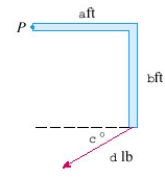
 ft,
ft,  ft,
ft,  ,
,  lb.
lb. 

Unlock Deck
Unlock for access to all 60 flashcards in this deck.
Unlock Deck
k this deck
28
Find  correct to three decimal places where
correct to three decimal places where  ,
,  ,
,  .
.
A)
B)
C)
D)
E)
 correct to three decimal places where
correct to three decimal places where  ,
,  ,
,  .
.A)

B)

C)

D)

E)


Unlock Deck
Unlock for access to all 60 flashcards in this deck.
Unlock Deck
k this deck
29
The tension T at each end of the chain has magnitude  N and makes an angle
N and makes an angle  with the horizontal. What is the weight of the chain? Round the result to the nearest hundredth.
with the horizontal. What is the weight of the chain? Round the result to the nearest hundredth. 
 N and makes an angle
N and makes an angle  with the horizontal. What is the weight of the chain? Round the result to the nearest hundredth.
with the horizontal. What is the weight of the chain? Round the result to the nearest hundredth. 

Unlock Deck
Unlock for access to all 60 flashcards in this deck.
Unlock Deck
k this deck
30
Find an equation of the plane through the origin and parallel to the plane 


Unlock Deck
Unlock for access to all 60 flashcards in this deck.
Unlock Deck
k this deck
31
Find the cross product  .
. 
A)
B)
C)
D)
E)
 .
. 
A)

B)

C)

D)

E)


Unlock Deck
Unlock for access to all 60 flashcards in this deck.
Unlock Deck
k this deck
32
Find parametric equations for the line through  and parallel to the vector
and parallel to the vector 
 and parallel to the vector
and parallel to the vector 

Unlock Deck
Unlock for access to all 60 flashcards in this deck.
Unlock Deck
k this deck
33
A bicycle pedal is pushed by a foot with a force of a-N as shown. The shaft of the pedal is  cm long.
cm long.
Find the magnitude of the torque about P correct to two decimal places.
Let N,
N,  ,
,  .
. 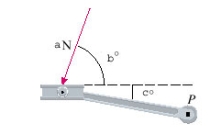
 cm long.
cm long.Find the magnitude of the torque about P correct to two decimal places.
Let
 N,
N,  ,
,  .
. 

Unlock Deck
Unlock for access to all 60 flashcards in this deck.
Unlock Deck
k this deck
34
Two forces  with magnitudes 8 lb and 12 lb act on an object at a point P as shown in the figure. Find the magnitude of the resultant force F acting at P. Round the result to the nearest tenth.
with magnitudes 8 lb and 12 lb act on an object at a point P as shown in the figure. Find the magnitude of the resultant force F acting at P. Round the result to the nearest tenth. 
A)
B)
C)
D)
E)
 with magnitudes 8 lb and 12 lb act on an object at a point P as shown in the figure. Find the magnitude of the resultant force F acting at P. Round the result to the nearest tenth.
with magnitudes 8 lb and 12 lb act on an object at a point P as shown in the figure. Find the magnitude of the resultant force F acting at P. Round the result to the nearest tenth. 
A)

B)

C)

D)

E)


Unlock Deck
Unlock for access to all 60 flashcards in this deck.
Unlock Deck
k this deck
35
Find a nonzero vector orthogonal to the plane through the points P, Q, and R. 
A)
B)
C)
D)
E)None of these

A)

B)

C)

D)

E)None of these

Unlock Deck
Unlock for access to all 60 flashcards in this deck.
Unlock Deck
k this deck
36
Find the unit vectors that are parallel to the tangent line to the curve  at the point
at the point  .
.
A)
B)
C)
D)
E)
 at the point
at the point  .
.A)

B)

C)

D)

E)


Unlock Deck
Unlock for access to all 60 flashcards in this deck.
Unlock Deck
k this deck
37
Velocities have both direction and magnitude and thus are vectors. The magnitude of a velocity vector is called speed. Suppose that a wind is blowing from the direction N 
 W at a speed of
W at a speed of  km/h. (This means that the direction from which the wind blows is
km/h. (This means that the direction from which the wind blows is 
 west of the northerly direction.) A pilot is steering a plane in the direction N
west of the northerly direction.) A pilot is steering a plane in the direction N 
 E at an airspeed (speed in still air) of
E at an airspeed (speed in still air) of  km/h. The true course, or track, of the plane is the direction of the resultant of the velocity vectors of the plane and the wind. The ground speed of the plane is the magnitude of the resultant. Find the ground speed of the plane. Round the result to the nearest hundredth.
km/h. The true course, or track, of the plane is the direction of the resultant of the velocity vectors of the plane and the wind. The ground speed of the plane is the magnitude of the resultant. Find the ground speed of the plane. Round the result to the nearest hundredth.

 W at a speed of
W at a speed of  km/h. (This means that the direction from which the wind blows is
km/h. (This means that the direction from which the wind blows is 
 west of the northerly direction.) A pilot is steering a plane in the direction N
west of the northerly direction.) A pilot is steering a plane in the direction N 
 E at an airspeed (speed in still air) of
E at an airspeed (speed in still air) of  km/h. The true course, or track, of the plane is the direction of the resultant of the velocity vectors of the plane and the wind. The ground speed of the plane is the magnitude of the resultant. Find the ground speed of the plane. Round the result to the nearest hundredth.
km/h. The true course, or track, of the plane is the direction of the resultant of the velocity vectors of the plane and the wind. The ground speed of the plane is the magnitude of the resultant. Find the ground speed of the plane. Round the result to the nearest hundredth.
Unlock Deck
Unlock for access to all 60 flashcards in this deck.
Unlock Deck
k this deck
38
Calculate the given quantities if 




Unlock Deck
Unlock for access to all 60 flashcards in this deck.
Unlock Deck
k this deck
39
Calculate the angle between a and b (correct to the nearest degree). 
A)
B)
C)
D)
E)None of these

A)

B)

C)

D)

E)None of these

Unlock Deck
Unlock for access to all 60 flashcards in this deck.
Unlock Deck
k this deck
40
Find an equation of the plane that passes through the point  and contains the line
and contains the line 
 and contains the line
and contains the line 

Unlock Deck
Unlock for access to all 60 flashcards in this deck.
Unlock Deck
k this deck
41
Find the length of each side of the triangle ABC and determine whether the triangle is an isosceles triangle, a right triangle, both, or neither. A (-1, 0, 1), B (1, 1, -1), C (1, 1, 1)
A)1, 1, , both
, both
B)3, 2, , right
, right
C)1, 2, , neither
, neither
D)1, 1, , isosceles
, isosceles
A)1, 1,
 , both
, bothB)3, 2,
 , right
, rightC)1, 2,
 , neither
, neitherD)1, 1,
 , isosceles
, isosceles
Unlock Deck
Unlock for access to all 60 flashcards in this deck.
Unlock Deck
k this deck
42
Draw a rectangular box with the origin and  as opposite vertices and with its faces parallel to the coordinate planes. Find the length of the diagonal of the box.
as opposite vertices and with its faces parallel to the coordinate planes. Find the length of the diagonal of the box.
 as opposite vertices and with its faces parallel to the coordinate planes. Find the length of the diagonal of the box.
as opposite vertices and with its faces parallel to the coordinate planes. Find the length of the diagonal of the box.
Unlock Deck
Unlock for access to all 60 flashcards in this deck.
Unlock Deck
k this deck
43
Find an equation of the sphere that passes through the point  and has center
and has center  .
.
 and has center
and has center  .
.
Unlock Deck
Unlock for access to all 60 flashcards in this deck.
Unlock Deck
k this deck
44
Find the center and the radius of the sphere that has the given equation.  +
+  +
+  - 6x + 4y = 0
- 6x + 4y = 0
A)( -3, 2, 0),
B)( 3, -2, 0), 13
C)( -3, 2, 0), 13
D)( 3, -2, 0),
 +
+  +
+  - 6x + 4y = 0
- 6x + 4y = 0A)( -3, 2, 0),

B)( 3, -2, 0), 13
C)( -3, 2, 0), 13
D)( 3, -2, 0),


Unlock Deck
Unlock for access to all 60 flashcards in this deck.
Unlock Deck
k this deck
45
Find the midpoint of the line segment joining the given points. (-5, 0, 2) and (-3, -2, 4)
A)( -4 ,-1 ,3 )
B)( ,
,  ,
,  )
)
C)( ,
,  ,
,  )
)
D)( ,
,  ,
,  )
)
A)( -4 ,-1 ,3 )
B)(
 ,
,  ,
,  )
)C)(
 ,
,  ,
,  )
)D)(
 ,
,  ,
,  )
)
Unlock Deck
Unlock for access to all 60 flashcards in this deck.
Unlock Deck
k this deck
46
Write an inequality to describe the half-space consisting of all points to the left of a plane parallel to the xz-plane and  units to the right of it.
units to the right of it.
 units to the right of it.
units to the right of it.
Unlock Deck
Unlock for access to all 60 flashcards in this deck.
Unlock Deck
k this deck
47
Write an inequality to describe the region consisting of all points between (but not on) the
spheres of radius and
and  centered at the origin.
centered at the origin.
spheres of radius
 and
and  centered at the origin.
centered at the origin.
Unlock Deck
Unlock for access to all 60 flashcards in this deck.
Unlock Deck
k this deck
48
a.Find an equation of the sphere that passes through the point  and has center
and has center  .
.
b.Find the curve in which this sphere intersects the xy-plane.
 and has center
and has center  .
. b.Find the curve in which this sphere intersects the xy-plane.

Unlock Deck
Unlock for access to all 60 flashcards in this deck.
Unlock Deck
k this deck
49
Sketch the plane in a three-dimensional space represented by the equation. z = 2
A)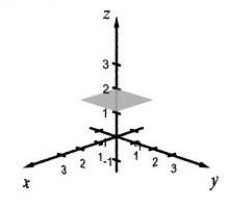
B)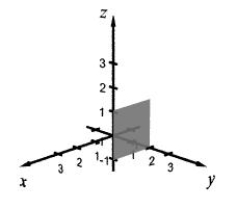
C)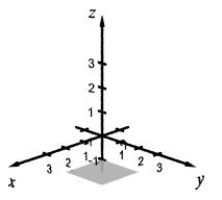
D)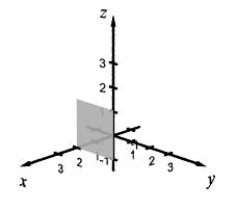
A)

B)

C)

D)


Unlock Deck
Unlock for access to all 60 flashcards in this deck.
Unlock Deck
k this deck
50
Find the center and radius of the sphere. 
A)
B)
C)
D)
E)none of these

A)

B)

C)

D)

E)none of these

Unlock Deck
Unlock for access to all 60 flashcards in this deck.
Unlock Deck
k this deck
51
Find the distance from  to the xy-planes.
to the xy-planes.
A)8
B)2
C)4
D)16
E)10
 to the xy-planes.
to the xy-planes.A)8
B)2
C)4
D)16
E)10

Unlock Deck
Unlock for access to all 60 flashcards in this deck.
Unlock Deck
k this deck
52
Write inequalities to describe the solid rectangular box in the first octant bounded by the
planes ,
,  , and
, and  .
.
planes
 ,
,  , and
, and  .
.
Unlock Deck
Unlock for access to all 60 flashcards in this deck.
Unlock Deck
k this deck
53
Plot the given points in a three-dimensional coordinate system. (1, 2, 3)
A)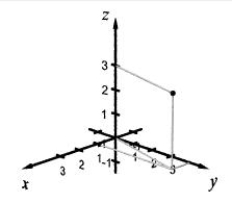
B)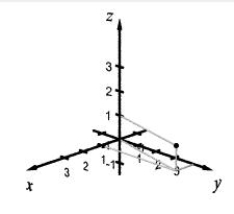
C)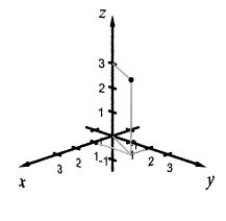
D)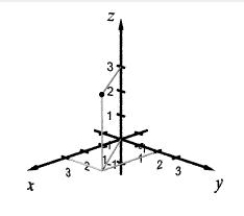
A)

B)

C)

D)


Unlock Deck
Unlock for access to all 60 flashcards in this deck.
Unlock Deck
k this deck
54
Find the length of the median of side AB of the triangle with vertices 




Unlock Deck
Unlock for access to all 60 flashcards in this deck.
Unlock Deck
k this deck
55
Find an equation of the sphere with center  that touches the xy-plane.
that touches the xy-plane.
A)
B)
C)
D)
E)
 that touches the xy-plane.
that touches the xy-plane.A)

B)

C)

D)

E)


Unlock Deck
Unlock for access to all 60 flashcards in this deck.
Unlock Deck
k this deck
56
Find the standard equation of the sphere with center C and radius r. C (3, -5, 3); r = 7
A)(x - 3)2 + (y + 5)2 + (z - 3)2 = 7
B)(x - 3)2 + (y + 5)2 + (z - 3)2 = 49
C)(x + 3)2 + (y - 5)2 + (z + 3)2 = 7
D)(x + 3)2 + (y - 5)2 + (z + 3)2 = 49
A)(x - 3)2 + (y + 5)2 + (z - 3)2 = 7
B)(x - 3)2 + (y + 5)2 + (z - 3)2 = 49
C)(x + 3)2 + (y - 5)2 + (z + 3)2 = 7
D)(x + 3)2 + (y - 5)2 + (z + 3)2 = 49

Unlock Deck
Unlock for access to all 60 flashcards in this deck.
Unlock Deck
k this deck
57
Suppose you start at the origin, move along the x-axis a distance of  units in the positive direction, and then move downward a distance of
units in the positive direction, and then move downward a distance of  units. What are the coordinates of your position?
units. What are the coordinates of your position?
A)
B)
C)
D)
E)
 units in the positive direction, and then move downward a distance of
units in the positive direction, and then move downward a distance of  units. What are the coordinates of your position?
units. What are the coordinates of your position?A)

B)

C)

D)

E)


Unlock Deck
Unlock for access to all 60 flashcards in this deck.
Unlock Deck
k this deck
58
Find that the midpoint of the line segment from  to
to  .
.
A)
B)
C)
D)
E)
 to
to  .
.A)

B)

C)

D)

E)


Unlock Deck
Unlock for access to all 60 flashcards in this deck.
Unlock Deck
k this deck
59
Write inequalities to describe the solid upper hemisphere of the sphere of radius  centered at the origin.
centered at the origin.
 centered at the origin.
centered at the origin.
Unlock Deck
Unlock for access to all 60 flashcards in this deck.
Unlock Deck
k this deck
60
Determine whether the given points are collinear. A (-3, -2, -3), B (-9, -5, 0), and C (-1, -1, -4)
A)Collinear
B)Not collinear
A)Collinear
B)Not collinear

Unlock Deck
Unlock for access to all 60 flashcards in this deck.
Unlock Deck
k this deck



